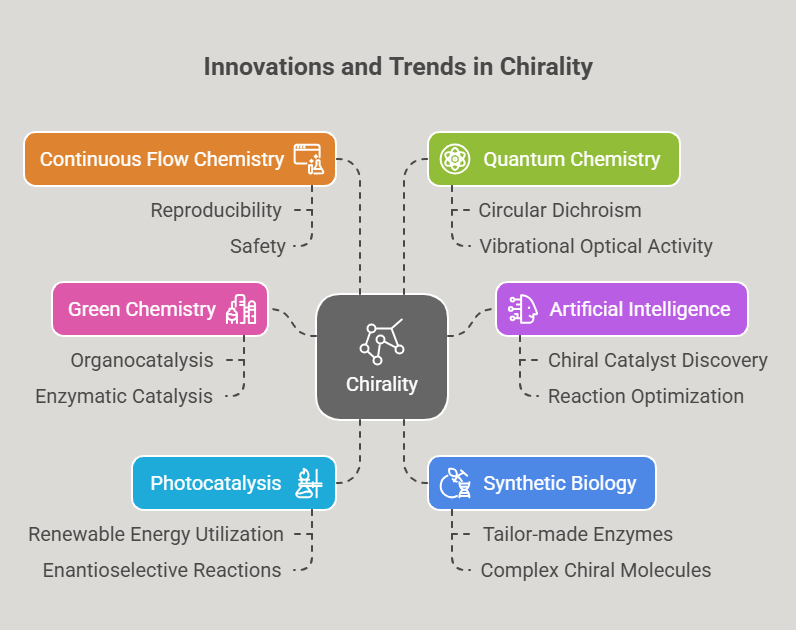As the study of chirality enters its next phase, it remains at the forefront of scientific exploration, bridging disciplines such as chemistry, biology, pharmacology, and material science. The journey from its foundational discoveries to the transformative breakthroughs in asymmetric synthesis and pharmaceutical applications has established chirality as a fundamental concept in understanding and manipulating molecular asymmetry. This final chapter provides a holistic summary of chirality’s journey, its underpinnings, and where it is headed in the future.
A Holistic Summary: The Journey of Chirality
The story of chirality began with Étienne-Louis Malus’ discovery of polarized light and Louis Pasteur’s groundbreaking work with tartaric acid crystals. These foundational insights revealed that molecular asymmetry is not merely an abstract concept but a profound natural phenomenon with wide-ranging implications. Early chemists, including Jacobus Henricus van’t Hoff and Joseph Achille Le Bel, extended this understanding by proposing three-dimensional molecular models, establishing the geometric basis for chirality and stereochemistry.
The incorporation of chirality into pharmacology and biology brought both triumphs and tragedies. The tragic thalidomide incident in the 1960s underscored the critical importance of understanding enantiomeric differences, spurring advancements in enantioselective synthesis and regulatory oversight. The advent of asymmetric catalysis in the latter half of the 20th century transformed chirality from a conceptual curiosity to a practical tool, enabling the development of enantiomerically pure drugs and materials with unparalleled precision.
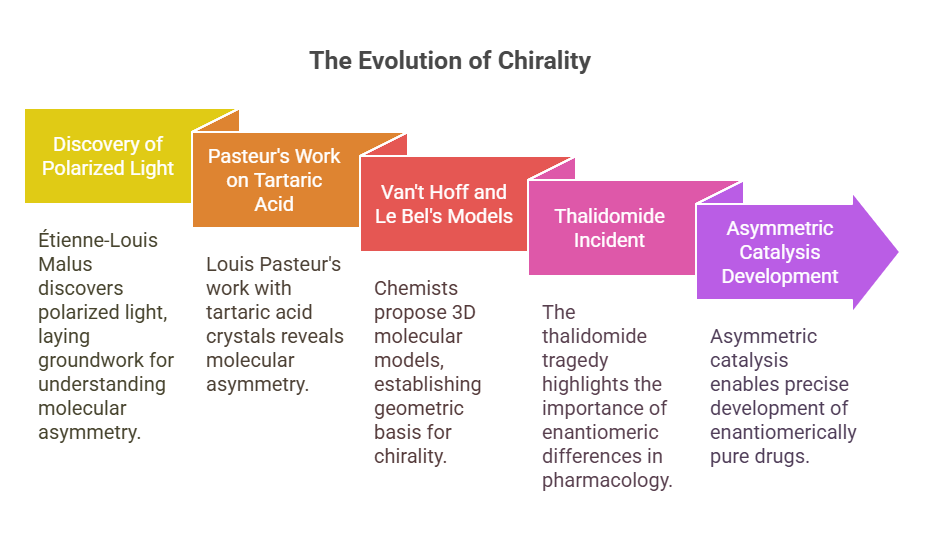
The Underpinnings of Chirality’s Importance
Chirality is a cornerstone of life itself. The molecular asymmetry observed in biomolecules like DNA, proteins, and carbohydrates is not coincidental but fundamental to their function. The specificity of enzyme-substrate interactions, the fidelity of DNA replication, and the behavior of drugs in the human body all depend on chirality. This asymmetry enables biological systems to distinguish between mirror-image molecules, a property that has been exploited in the design of pharmaceuticals, agrochemicals, and advanced materials.
From a chemical perspective, chirality represents a unique interplay of symmetry and asymmetry, with profound implications for reactivity, selectivity, and function. The ability to control and manipulate chirality has unlocked new dimensions in synthesis, allowing chemists to design molecules with tailored properties. The broader applications of chirality extend beyond biology, influencing fields such as optics, materials science, and nanotechnology.
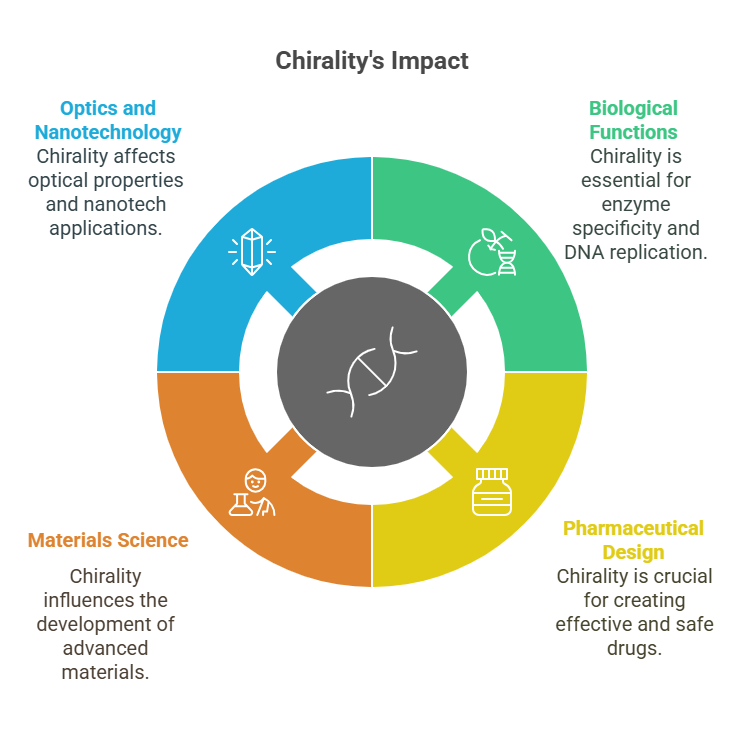
Current Trends and Innovations
As chirality continues to evolve as a scientific frontier, several trends and innovations are shaping its future:
1. Green Chemistry and Sustainable Synthesis
The drive for sustainability in chemical processes has led to a focus on greener methods for asymmetric synthesis. Organocatalysis, enzymatic catalysis, and photocatalysis offer pathways to achieve high enantioselectivity without relying on toxic metals or harsh reaction conditions. These approaches align with the principles of green chemistry, reducing waste and energy consumption while maintaining efficiency and precision.
2. Artificial Intelligence and Machine Learning
AI and machine learning are revolutionizing the study of chirality by accelerating the discovery of chiral catalysts, optimizing reaction conditions, and predicting stereochemical outcomes. Computational tools are enabling chemists to explore vast chemical spaces and identify novel chiral structures with potential applications in drug development and materials science.
3. Photocatalysis and Electrocatalysis
The use of light and electricity to drive enantioselective reactions is an emerging field with significant promise. Photocatalysis and electrocatalysis offer sustainable and innovative methods for asymmetric synthesis, harnessing renewable energy sources to achieve high selectivity and efficiency.
4. Synthetic Biology and Biocatalysis
Advances in synthetic biology are enabling the design of tailor-made enzymes for asymmetric transformations. Biocatalysis, leveraging nature’s own catalysts, offers unmatched selectivity and efficiency, particularly in the production of complex chiral molecules. This approach is particularly valuable in the pharmaceutical industry, where precision is paramount.
5. Continuous Flow Chemistry
Continuous flow systems are transforming the scalability of asymmetric synthesis. By enabling reactions to occur in a controlled and continuous manner, flow chemistry enhances reproducibility, efficiency, and safety. This innovation is particularly valuable for industrial applications, where large-scale production of chiral compounds is required.
6. Quantum Chemistry and Chiral Analysis
The study of chirality is entering the quantum realm, where subtle differences in energy and interaction can influence stereochemical behavior. Advanced spectroscopic techniques, including circular dichroism and vibrational optical activity, are providing new insights into chiral interactions at the molecular level. These tools are expanding our ability to analyze and manipulate chirality with unprecedented precision.
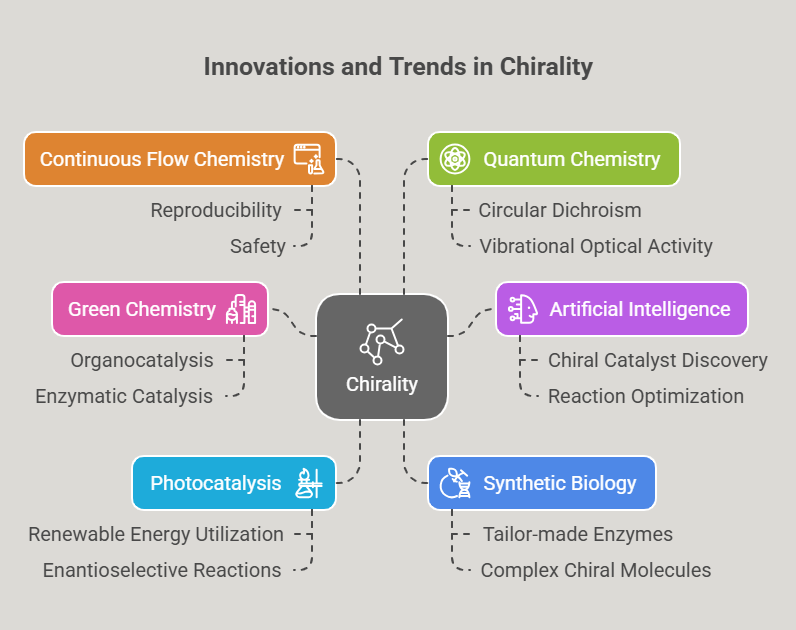
Applications Beyond Pharmaceuticals
While chirality has transformed the pharmaceutical industry, its applications extend far beyond drug development:
Advanced Materials
Chiral polymers and liquid crystals are being developed for applications in optics, electronics, and sensing. These materials exhibit unique properties, such as circularly polarized light emission and selective absorption, driven by their molecular asymmetry.
Agriculture
Chirality plays a critical role in agrochemicals, where enantiomerically pure pesticides and herbicides offer improved efficacy and reduced environmental impact.
Nanotechnology
The study of chirality at the nanoscale is opening new possibilities in nanomedicine, catalysis, and energy storage. Chiral nanoparticles and surfaces exhibit unique interactions with light and matter, enabling novel applications in sensing and diagnostics.
Optics and Electronics
Chirality is influencing the design of optical and electronic devices, including circularly polarized light detectors, chiral photonics, and spintronic materials. These technologies are advancing fields such as telecommunications, data storage, and quantum computing.
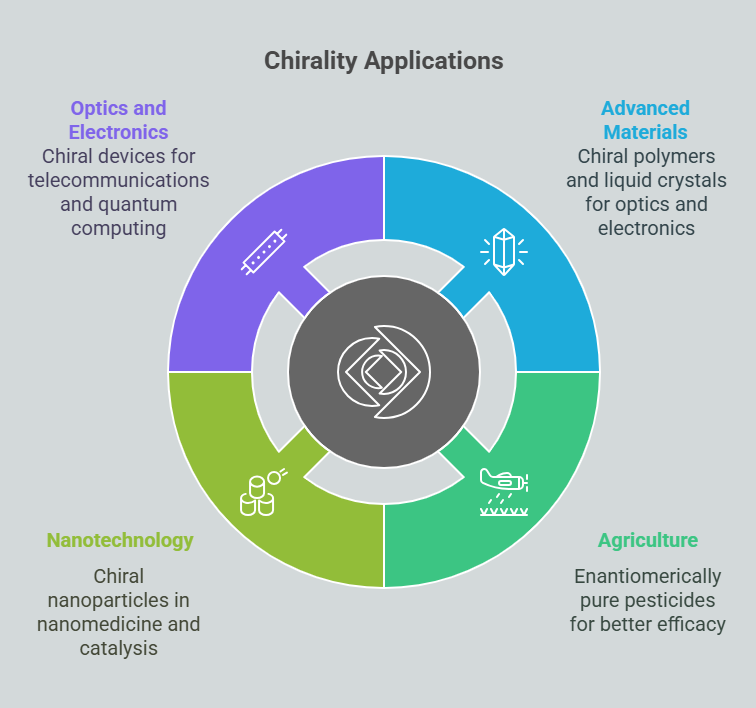
Challenges on the Horizon
Despite its progress, the study and application of chirality face several challenges:
Scalability and Cost: Scaling up enantioselective processes while maintaining efficiency and selectivity remains a technical and economic challenge.
Regulatory and Ethical Considerations: The use of chiral compounds, particularly in pharmaceuticals and agrochemicals, requires stringent regulatory oversight to ensure safety and efficacy.
Interdisciplinary Integration: As chirality intersects with fields such as biology, physics, and materials science, fostering interdisciplinary collaboration is essential for unlocking its full potential.
The Future of Chirality: Where We Are Headed
The future of chirality lies in its integration across disciplines and its application to solve global challenges. By combining advances in chemistry, biology, physics, and engineering, chirality will continue to drive innovation in areas such as:
Personalized Medicine: The ability to design chiral drugs tailored to individual patients’ genetic and metabolic profiles will enhance the precision and efficacy of treatments.
Renewable Energy: Chiral materials are being explored for applications in solar energy harvesting, hydrogen production, and energy storage, contributing to sustainable energy solutions.
Environmental Remediation: Chiral catalysts and enzymes offer potential solutions for breaking down pollutants and recycling waste materials, supporting environmental sustainability.
Quantum Technologies: The intersection of chirality and quantum mechanics is unlocking new possibilities in computing, communication, and sensing technologies.

Conclusion: The Endless Asymmetry of Progress
The journey of chirality is a testament to the power of human curiosity and innovation. From its humble beginnings in the study of polarized light to its transformative impact on science and society, chirality has redefined our understanding of molecular interactions and their applications. As we look to the future, the challenges and opportunities of chirality promise to inspire the next generation of scientists, engineers, and innovators.
By embracing the principles of chirality, we are not only advancing the frontiers of knowledge but also addressing some of the most pressing challenges facing humanity. The asymmetry of nature, once a source of mystery, has become a catalyst for progress, shaping the way we understand and interact with the world around us.
References and Further Reading
Sheldon RA (2016). “Green Chemistry and Catalysis.” Chemical Reviews.
List B, MacMillan DW (2021). “Organocatalysis: The Path to Simplicity and Sustainability.” Angewandte Chemie International Edition
